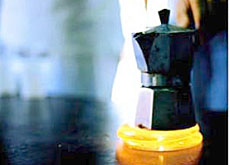Photographer uncovers secrets of “Glass Island”

The glassblowers of Murano, an island near the Italian city of Venice, have kept the secrets of their unique workmanship hidden from outsiders for centuries.
A Swiss photographer managed to earn their trust, and an exhibition of his pictures has now gone on show at the Image House Gallery in Zurich.
Jürg Waldmeier, a 40-year-old professional photographer from Zug, spent three years observing the glassblowers of Murano and capturing their work.
But Waldmeier says taking photographs was not always easy as the glassblowers were worried about revealing the secrets of their trade.
“It was difficult to get permission from the people to photograph them,” he told swissinfo.
“I had to visit them a few times beforehand to convince them that my pictures did not show any details of their work.”
Italian exhibition
Earlier this year, Waldmeier staged an exhibition in Venice. Even though he invited all the craftsmen who took part in his series, not one of them took up his invitation.
“During my time on the island, I showed them my pictures but they were not really interested. When I invited them to my exhibition in Venice, none of them showed up,” he said.
“The glassblowers of Murano are very proud people – they probably thought that the ‘Svizzero’ had no clue about their unique trade.”
Waldmeier’s pictures – including one of an empty glassblowers’ school cafeteria – also capture one his concerns: that the centuries-old tradition is in danger of dying out.
The photographer says fewer young people are interested in learning the trade.
“I think in 20 years’ time this craft could die out. I went to this school at the beginning of the term and it was empty,” Waldmeier told swissinfo.
“There are some young people in the trade but they are treated very badly. It takes a long time to become a maestro, and for the first two years they might only be allowed to polish the glass.”
Commercial port
In 1291 the Venetian Republic ordered the glassmakers to move their foundries to the island, claiming the glassworks posed a fire hazard in Venice, where most of the buildings were made of wood.
It did not take long for Murano’s glassmakers to become the leading citizens on the island, where the population now numbers around 5,000.
But they were kept on a tight rein. “If a craftsman left the island, he risked being assassinated or having his head cut off by the secret police,” says Waldmeier.
What made Murano’s craftsmen so special was the fact that they were the only people in Europe who knew how to make a mirror.
After that they developed technologies such as crystalline glass, enamelled glass or even glass with threads of gold.
“Their glass is used for everything – lamps, bottles, lampshades or for pieces of art,” he says.
“Today the glass is mainly sold to tourists and that’s a shame, because the tourists are not really interested in quality. That means the glassblowers have lost their quality control.”
A book of Waldmeier’s photographs was published in Switzerland last month.
swissinfo, Billi Bierling
Waldmeier observed and took photographs of the glassblowers of Murano between 1999 and 2001.
The exhibition at the Image House Gallery in Zurich runs until November 22.
The book “Murano” is available in bookshops all over Switzerland or on Waldmeier’s homepage (www.juergwaldmeier.ch)
The book costs SFr54 and it is also available in Germany and Austria for €32.50.

In compliance with the JTI standards
More: SWI swissinfo.ch certified by the Journalism Trust Initiative
You can find an overview of ongoing debates with our journalists here. Please join us!
If you want to start a conversation about a topic raised in this article or want to report factual errors, email us at english@swissinfo.ch.